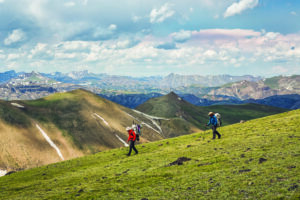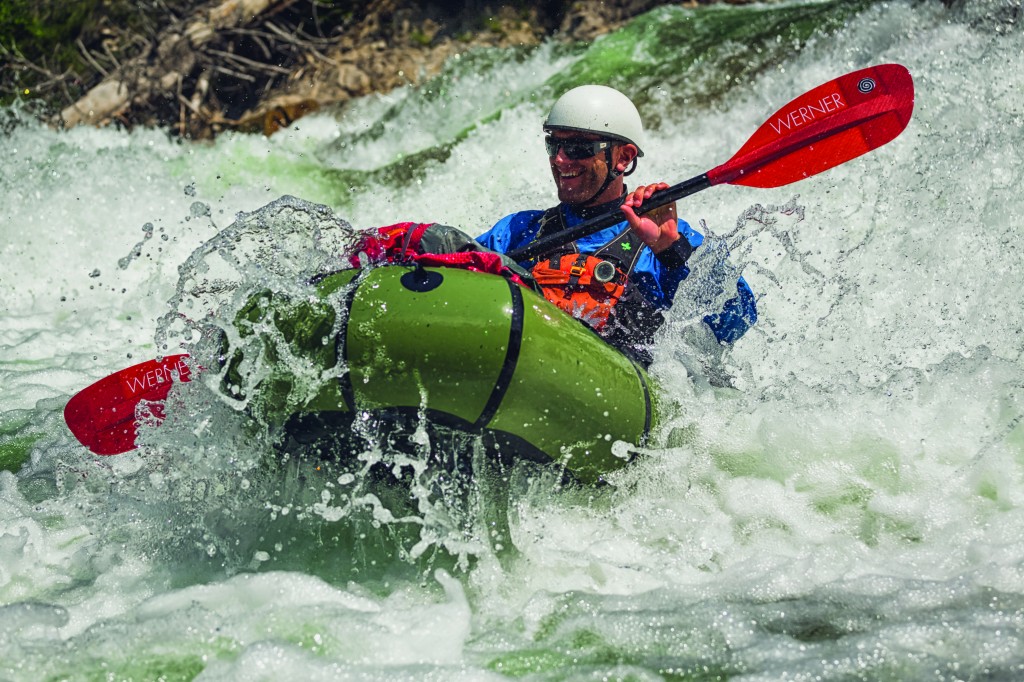Yellowstone
Wilderness paddling: The Thorofare
Published
10 years agoon
Posted By
Outlaw PartnersBy Forrest McCarthy
It’s an apt name. For American Indians and early trappers, the broad valley known today as the Thorofare provided easy passage through the otherwise inaccessible southern Absaroka Range. They followed the trails of bison, elk and bighorn sheep that for millennia have migrated through this lush mountain paradise.
Located amid 2.1 million contiguous acres of roadless wilderness, the creek that flows along the valley’s bottom is arguably the most remote waterway in the Lower 48. There’s no easy way in or out. The shortest trail from its bank to a road is 25 miles long and crosses the continental divide. By the time it joins the Yellowstone, Thorofare Creek is the size of a small river.
Camped at its headwaters with a rag-tag crew of four trusted companions, I watch the sun descend behind the triple 11,000-foot summits of the Trident. Volcanic breccias sculpted into steep ridges and canyons by Pleistocene ice are backlit by the orange sphere. We relax on a gravel bar, warding off the evening chill and heating water for the night’s meal over a crackling driftwood fire.
Earlier in the day we’d trekked 11 miles up Fall Creek and down into Bruin Creek, crossing the Absaroka Crest by way of a 11,297-foot trail-less pass. Yesterday, to reach Fall Creek, we paddled the South Fork of the Shoshone River for 20 miles through the Washakie Wilderness. The day before we hiked 15 miles over Shoshone Pass from the Du Noir near Dubois, Wyoming.
After three strenuous days, we’re looking forward to tomorrow’s leisurely float down Thorofare Creek. The wild landscape guides our thoughts and conversation, reminding me of words written nearly a century ago.
“To countless people the wilderness provides the ultimate delight because it combines the thrills of jeopardy and beauty,” wrote Bob Marshall, founder of the Wilderness Society. “It is the last stand for that glorious adventure into the physically unknown.”
In the morning we pack our few pounds of camping gear and provisions into lightweight one-man inflatable packrafts and begin the 17-mile paddle through the Teton Wilderness to the southeast border of Yellowstone National Park.
 We’ll exit the river there, because floating on park rivers is prohibited by a 1950s-era law designed to protect against overfishing. A federal offense, it is punishable with hefty fines, confiscated gear and possible jail time.
We’ll exit the river there, because floating on park rivers is prohibited by a 1950s-era law designed to protect against overfishing. A federal offense, it is punishable with hefty fines, confiscated gear and possible jail time.
Paddling in Wilderness areas is legal, however, and many of the architects of the 1964 Wilderness Act, including Sigurd Olson and Olaus Murie, were in fact paddlers.
“When you go into country by pack train the streams are only for crossing, or to camp beside. To know a stream you travel on it, struggle with it, live with it hour by hour and day by day,” wrote Murie, after canoeing the Yellowstone River in the late 1930s with his two sons.
During the day we spend on Thorofare Creek, the views change constantly. Early on, we navigate a long braided section. The current is swift, and we pilot our packrafts into the largest channels. Through thick stands of lodgepole pine, the rocky summits of the Thorofare Buttes come in and out of view.
Then, above Petrified Ridge, the glaciated peaks of Mount Overlook and Ishawooa Cone appear. On the riverbank a bald eagle feasts on a cutthroat trout. I pass close enough to see her individual feathers.
Near the confluence with Butte Creek, the channels merge and the creek bends west. We drift through a shallow gorge of ancient lava, vertical walls of the brittle igneous rock guiding the current.
The valley opens again as we meet Pass Creek. In a meadow of lupine, yarrow and grass, a herd of elk grazes. Below Open Creek, a bull moose, its rack covered in dark velvet, watches as we pass.
As we approach the park boundary that afternoon, the 9,761-foot Hawks Rest seems to grow in stature. Notable as the farthest peak from a road in the contiguous states, it also marks the convergence of the Thorofare and Yellowstone valleys and the end of our time on Thorofare Creek. We exit our rafts at a gravel bar, and dry our gear in the sun, resting and taking our last look up Thorofare Valley.


From here, we roll up our boats and trek 20 miles across Two-Ocean Pass and the Continental Divide to the Buffalo Fork River, then the following day paddle 15 swift miles through a series of whitewater canyons into Jackson Hole, Wyoming.
Like many paddlers, I often seek the challenge and thrill of roadside whitewater. But I find that spending days in the wilderness, harmonizing my internal rhythms with the natural hypnotic pace of free flowing water allows a much fuller understanding of a river’s riches.
In the words of Bob Marshall:
“Swift or smooth, broad as the Hudson or narrow enough to scrape your gunwales, every river is a world of its own, unique in pattern and personality. Each mile on a river will take you further from home than a hundred miles on a road.”
Forrest McCarthy, a wilderness advocate and explorer, is a longtime student of both Bob Marshall and Olaus Murie. Next to his desk sits all of their published writings.
__________
River Paddling Protection Act
Paddling on most Yellowstone National Park rivers was banned in 1950, due to concerns about overfishing, and Grand Teton adopted similar regulations a few years later. A bill currently in Congress aims to change that.
The U.S. House of Representatives on February 6, 2014 passed the River Paddling Protection Act, which would open up rivers in both parks, as well as Jackson’s National Elk Refuge. Passed as part of the Public Access and Lands Improvement Act, the legislation was introduced on its own in the Senate by John Barrasso, R-Wyo., on February 12.
The Department of the Interior opposes the bill, as do a number of conservation and local recreation groups. Supporters point to the declining number of backcountry users in the parks and refuge, as well as to other public lands that have opened their paddling resources.
If passed, park authorities would have three years to develop management guidelines before lifting the ban.
– Tyler Allen
This story was first published in the summer 2014 issue of Mountain Outlaw magazine.
The Outlaw Partners is a creative marketing, media and events company based in Big Sky, Montana.


Upcoming Events
november, 2024
Event Type :
All
All
Arts
Education
Music
Other
Sports
Event Details
Spanish Classes with World Language InitiativeThese unique, no cost Spanish classes are made possible by the contribution of Yellowstone Club
more
Event Details
Spanish Classes with World Language InitiativeThese unique, no cost Spanish classes are made possible by the contribution of Yellowstone Club Community Foundation (YCCF) and Moonlight Community Foundation (MCF). This class will focus on building a lifelong affinity for world languages and cultures through dynamic and immersive Communicative Language teaching models.
Beginner Class – Mondays and Wednesdays from 5:30-6:30 pm
Intermediate Class – Mondays and Wednesdays from 6:45- 7:45 pm
- Classes begin Oct.7, 2024 and run for 6 weeks
- Class size is limited to 12 students
- Classes are held in Big Sky at the Big Sky Medical Center in the Community Room
For more information or to register follow the link below or at info@wlimt.org.
Time
October 21 (Monday) 5:30 pm - November 27 (Wednesday) 7:45 pm
Location
Big Sky Medical Center - Community Room (2nd Floor)
Big Sky Medical Center - Community Room (2nd Floor)
Event Details
Spanish Classes with World Language InitiativeThese unique, no cost Spanish classes are made possible by the contribution of Yellowstone Club
more
Event Details
Spanish Classes with World Language InitiativeThese unique, no cost Spanish classes are made possible by the contribution of Yellowstone Club Community Foundation (YCCF) and Moonlight Community Foundation (MCF). This class will focus on building a lifelong affinity for world languages and cultures through dynamic and immersive Communicative Language teaching models.
Beginner Class – Mondays and Wednesdays from 5:30-6:30 pm
Intermediate Class – Mondays and Wednesdays from 6:45- 7:45 pm
- Classes begin Oct.7, 2024 and run for 6 weeks
- Class size is limited to 12 students
- Classes are held in Big Sky at the Big Sky Medical Center in the Community Room
For more information or to register follow the link below or at info@wlimt.org.
Time
October 28 (Monday) 5:30 pm - December 4 (Wednesday) 7:45 pm
Location
Big Sky Medical Center - Community Room (2nd Floor)
Big Sky Medical Center - Community Room (2nd Floor)
Event Details
Spanish Classes with World Language InitiativeThese unique, no cost Spanish classes are made possible by the contribution of Yellowstone Club
more
Event Details
Spanish Classes with World Language InitiativeThese unique, no cost Spanish classes are made possible by the contribution of Yellowstone Club Community Foundation (YCCF) and Moonlight Community Foundation (MCF). This class will focus on building a lifelong affinity for world languages and cultures through dynamic and immersive Communicative Language teaching models.
Beginner Class – Mondays and Wednesdays from 5:30-6:30 pm
Intermediate Class – Mondays and Wednesdays from 6:45- 7:45 pm
- Classes begin Oct.7, 2024 and run for 6 weeks
- Class size is limited to 12 students
- Classes are held in Big Sky at the Big Sky Medical Center in the Community Room
For more information or to register follow the link below or at info@wlimt.org.
Time
November 4 (Monday) 5:30 pm - December 11 (Wednesday) 7:45 pm
Location
Big Sky Medical Center - Community Room (2nd Floor)
Big Sky Medical Center - Community Room (2nd Floor)









